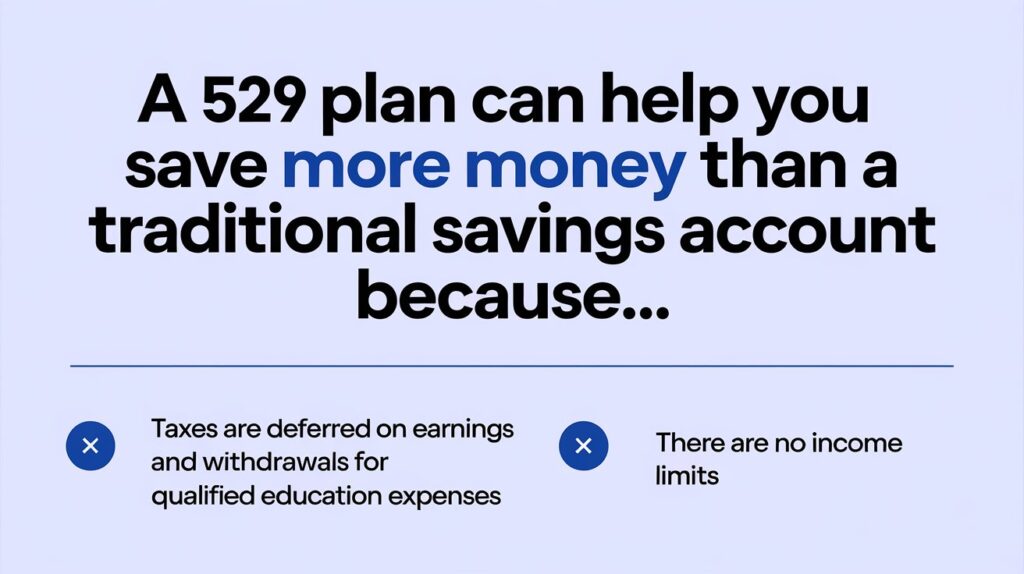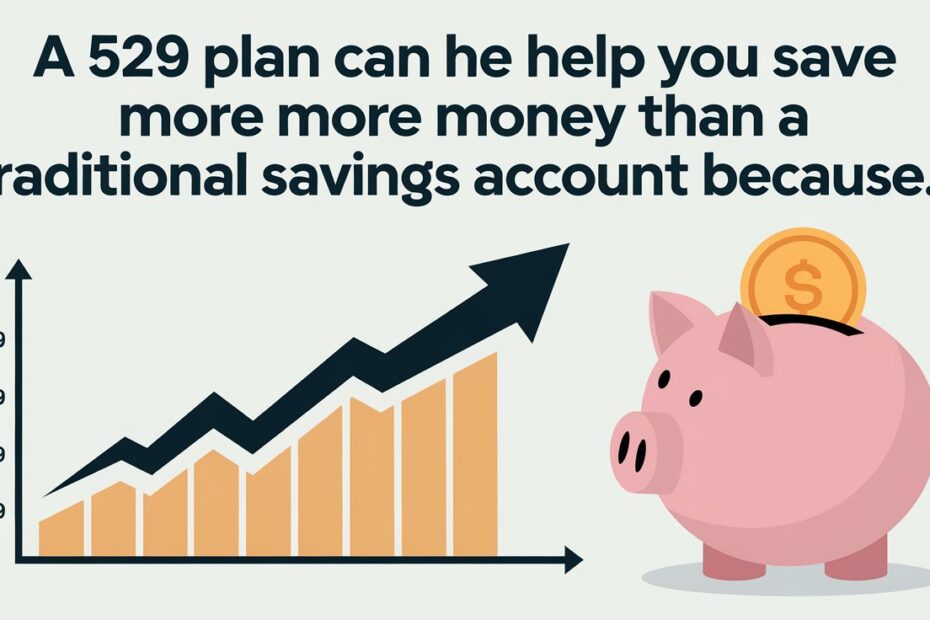Saving for education can be daunting, but making the right financial choices can ease that burden. One question often arises is whether to use a traditional savings account or explore other options like a 529 plan. A 529 Plan Can Help You Save More Money Than a Traditional Savings Account Because… it provides several tax advantages, investment flexibility, and long-term growth potential that traditional savings accounts can’t match.
Let’s dive into why choosing a 529 plan could significantly boost your savings for future education expenses.
Tax Advantages: A Game-Changer
One of the most compelling reasons A 529 Plan Can Help You Save More Money Than a Traditional Savings Account Because… of its remarkable tax benefits. In a 529 plan, the money you contribute grows tax-deferred. As your investments grow, you aren’t required to pay federal income taxes on the earnings. Those withdrawals are tax-free if you use the funds for qualified education expenses, like tuition or books.
Contrast that with a traditional savings account, where any interest you earn is subject to federal and sometimes state income taxes. Year after year, the taxes you pay on the interest in a traditional savings account could erode your savings, making a 529 plan the more efficient option for long-term education savings.
State Tax Deductions and Credits
Many states allow residents to deduct contributions to their state-sponsored 529 plans from their taxable income or provide state tax credits. This is an additional way A 529 Plan Can Help You Save More Money Than a Traditional Savings Account Because… it effectively reduces your state income tax burden. The specifics of this benefit can vary by state, but it’s a powerful incentive generally unavailable with a regular savings account.
Traditional savings accounts need this tax benefit, meaning you’ll likely miss out on potential savings at tax time.

More significant Growth Potential Through Investments
One of the key features that differentiates a 529 plan from a traditional savings account is its investment options. A 529 Plan Can Help You Save More Money Than a Traditional Savings Account Because… it allows you to invest in a mix of stocks, bonds, and mutual funds. Careful planning could lead to higher returns over time, depending on market performance.
On the other hand, traditional savings accounts are much more conservative in their growth. The interest rates on savings accounts are generally low, especially in today’s economic climate. While the funds in a savings account are secure and stable, their growth is limited, and inflation can diminish the actual value of your savings. If you’re looking for more significant long-term growth potential, a 529 plan’s investment options can outpace what a traditional savings account offers.
Flexibility and Control Over the Funds
Another reason a 529 plan can help you save more money than a traditional savings account is its flexibility. In a 529 plan, if the original beneficiary (such as your child) decides not to go to college or receives a scholarship, you can transfer the funds to another eligible family member without penalties. This feature allows you to keep the funds within the family for education purposes, ensuring that your hard-earned savings don’t go to waste.
In contrast, a traditional savings account offers a different level of flexibility. Once the funds are there, they are meant for general purposes, and reallocating them specifically for another person’s education doesn’t offer any particular benefit. The adaptability of a 529 plan ensures that your contributions remain valuable and relevant even if plans change.
Financial Aid Considerations: Minimizing the Impact
Parents often worry that saving for their child’s education might hurt their chances of receiving financial aid. Here’s where A 529 Plan Can Help You Save More Money Than a Traditional Savings Account Because… it is considered a parental asset. Only a tiny percentage of parental assets are factored in when calculating federal financial aid eligibility. This makes it a strategic choice compared to a traditional savings account, which may count more heavily against you in financial aid assessments.
Moreover, using a 529 plan to cover education costs can lower your child’s financial need, reducing the gap that needs to be filled with costly student loans.
No Contribution Limits in Traditional Savings Accounts, But Are They Enough?
A traditional savings account has no annual contribution limits, which can be. However, a 529 plan can help you save more money than a traditional savings account because while it may have contribution limits based on state laws, these limits are very high—usually upwards of $300,000 to $500,000 per beneficiary. Given the rising cost of education, especially for private institutions or out-of-state tuition, these high contribution limits allow you to save more than adequately for a child’s entire education.
In contrast, while traditional savings accounts do not have contribution caps, their slow growth and lack of tax incentives make them less effective in accumulating the substantial savings needed for higher education.
Scholarships and Grants: Benefiting Without Penalties
There’s a concern some people have when considering saving for education: “What if my child gets a scholarship or grant? Will my savings go to waste?” A 529 Plan Can Help You Save More Money Than a Traditional Savings Account Because… if your child earns a scholarship, you can withdraw up to the amount from the 529 plan without incurring the usual 10% penalty. Though you must pay taxes on the earnings, the tax-deferred growth still gives you a financial advantage over traditional savings.

Also Read: Why Does the Suez Canal Keep Getting Blocked and What Is the …
The Bottom Line: Long-Term Savings Success
Ultimately, A 529 Plan Can Help You Save More Money Than a Traditional Savings Account Because… it offers a combination of tax savings, higher growth potential through investments, flexibility, and state benefits. It’s a forward-thinking solution for families looking to maximize their education savings, making it far superior to the limited capabilities of a traditional savings account.
While traditional savings accounts provide a safe place to keep money for short-term needs, the slow growth and lack of tax incentives make them less effective when saving for something as significant as higher education. Choosing a 529 plan instead can ensure your education savings work harder for you, setting your family up for long-term success.
How to Get Started?
Are you interested in learning more about how a 529 plan could work for your family? Whether you are just beginning to save or considering options for an older child, now is the perfect time to explore how a 529 plan can help you save more money than a traditional savings account because it provides robust, long-lasting financial benefits. Take the next step and investigate which 529 plan options best align with your financial goals and educational needs.
The future of education savings is brighter with a 529 plan—don’t miss out on its advantages.

Pingback: Rena Monrovia when you transport something by car ...
Pingback: Kelly Bates asks supporters not to take out their anger on NBC 10 …